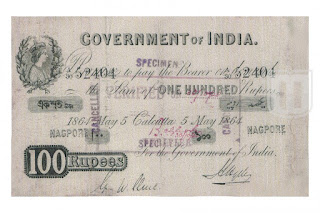Note Collectors or notaphilists who are new to notes of India, need to have a basic understanding about the different categories. Let's quickly go through the three main categories of notes in India, so that you have a clear direction and vision before you start putting together a collection.
Private and semi-government banks like the Bank of Hindostan, the General Bank in Bengal and Bahar, the Bengal Bank issued some of the oldest Indian note in the 18th century. These notes were issued for three presidencies namely, Bengal, Bombay and Madras, for ease of administration. Old notes of India issued by Bank of Bengal featured designs only on one side and were termed as Uniface Notes. Commerce Notes featuring an allegorical female figure personifying 'commerce' were issued later with designs on both sides. Urdu, Bengali and Devanagari languages were used on these rare note of India. Note belonging to the Britannia series with better security features and complex designs were issued by the end of the 19th century. Bank of Bombay issued early Indian note from 1850 to 1860 and they featured Town Hall of Bombay, statues of Sir Mountstraut Elphinstone and Sir John Malcom. The Bank of Madras was established in 1843 by merging Carnatic Bank (Est. 1788), the Madras Bank (Est. 1795) and the Asiatic Bank (Est. 1804). Madras Bank was the first bank in India which issued old Indian notes from 1682. Bank of Madras notes depicted Sir Thomas Munroe, Governor of Madras.
 |
| 5 Rupees Bombay Presidency Note |
After the Paper Currency Act of 1861 became effective, the Government took the complete responsibility of issuing notes in India. Presidency Banks became agents for the issue. Currency Circles were introduced to prevent liquidation. The agreements with Presidency Banks were terminated in 1897 and the Government took complete control. Currency note of India from the Victoria Portrait Series featured uniface designs and were printed on handmade paper manufactured at the Laverstock Paper Mills. These old notes of India were cut into half. The first half was sent to the receiver and the second half was sent again after the receipt was confirmed. The Underprint Series was introduced in 1867 with better security features to combat counterfeiting activities. The very first Indian notes from the King's Portrait Series were introduced in May 1923 featuring a portrait of King George V. All British India notes issued after this featured this design. The Currency Note Press in Nasik started printing currency notes in India from 1928. The Reserve Bank of India became the controller of Currency in 1935. Security features were improved further and multicolour printing was also used. Notes depicting a portrait of Edward VIII were supposed to be printed in 1937. But Edward was abdicated from the throne and notes featuring the portrait of King George VI were issued in 1938.
 |
| 100 Rupees Portrait Note of Queen Victoria |
The reserve bank of India continued to issue extant notes even after independence until the republic of India was formed on 26th January 1950. The designs for the very first republic India notes bore the denomination 1 rupee and were issued in the year 1949. Initially, it was almost decided that these notes of India would feature a portrait of Mahatma Gandhi. However, at the last moment, a design featuring the Lion Capital at Sarnath was chosen. Hindi language was highlighted on notes in India from 1953. Rs 1,000, Rs. 5,000, Rs. 10,000 were introduced again in 1954. The note size was reduced in 1967 to cut costs as the country was facing an economic downfall. A special commemorative series featuring a seated Gandhi and Sevagram Ashram in the background was released in 1969 to celebrate the 100th birth anniversary of Mahatma Gandhi. Rs. 20 and Rs. 50 notes were issued in 1972 and 1975, respectively. High denomination notes were abolished in 1972. Themes like Science & Technology, Progress, Farm Mechanisation, Indian Art were highlighted through the designs featured on notes of India from the 1980s. Rupee 500 note with a portrait of Mahatma Gandhi was introduced in 1987 to support the rising economy of India. The 'Mahatma Gandhi Series' with better security features was introduced in 1996.
 |
| 1 Rupee Banknote of Republic India |
The currency notes of India has witnessed a lot of changes in terms of designs, denominations and security features. By closely studying the different categories of Indian notes, you will be able to create an exciting collection indeed!